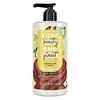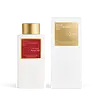What's inside
What's inside
 Key Ingredients
Key Ingredients

 Benefits
Benefits

 Concerns
Concerns

 Ingredients Side-by-side
Ingredients Side-by-side

Water
Skin ConditioningGlycerin
HumectantStearic Acid
CleansingGlycine Soja Oil
EmollientGlycol Stearate
EmollientTriethanolamine
BufferingGlyceryl Stearate
EmollientPhenoxyethanol
PreservativeCaprylyl Glycol
EmollientCetyl Alcohol
EmollientParfum
MaskingHydroxyethylcellulose
Emulsion StabilisingCarbomer
Emulsion StabilisingDisodium EDTA
BHT
AntioxidantStearamide Amp
Astrocaryum Vulgare Kernel Oil
Skin ConditioningVanilla Planifolia Fruit Extract
Skin ConditioningBenzyl Alcohol
PerfumingHexyl Cinnamal
PerfumingWater, Glycerin, Stearic Acid, Glycine Soja Oil, Glycol Stearate, Triethanolamine, Glyceryl Stearate, Phenoxyethanol, Caprylyl Glycol, Cetyl Alcohol, Parfum, Hydroxyethylcellulose, Carbomer, Disodium EDTA, BHT, Stearamide Amp, Astrocaryum Vulgare Kernel Oil, Vanilla Planifolia Fruit Extract, Benzyl Alcohol, Hexyl Cinnamal
Water
Skin ConditioningParaffinum Liquidum
EmollientGlycerin
HumectantParfum
MaskingGlyceryl Stearate Se
EmulsifyingPEG-40 Hydrogenated Castor Oil
EmulsifyingBenzyl Alcohol
PerfumingOleth-10
EmulsifyingStearic Acid
CleansingButyrospermum Parkii Butter
Skin ConditioningPolyacrylamide
Palmitic Acid
EmollientCarbomer
Emulsion StabilisingOleth-5
EmulsifyingC13-14 Isoparaffin
EmollientSodium Hydroxide
BufferingDehydroacetic Acid
PreservativeLaureth-7
EmulsifyingBHT
AntioxidantHexyl Cinnamal
PerfumingLinalool
PerfumingBenzyl Benzoate
AntimicrobialWater, Paraffinum Liquidum, Glycerin, Parfum, Glyceryl Stearate Se, PEG-40 Hydrogenated Castor Oil, Benzyl Alcohol, Oleth-10, Stearic Acid, Butyrospermum Parkii Butter, Polyacrylamide, Palmitic Acid, Carbomer, Oleth-5, C13-14 Isoparaffin, Sodium Hydroxide, Dehydroacetic Acid, Laureth-7, BHT, Hexyl Cinnamal, Linalool, Benzyl Benzoate
Ingredients Explained
These ingredients are found in both products.
Ingredients higher up in an ingredient list are typically present in a larger amount.
Benzyl Alcohol is most commonly used as a preservative. It also has a subtle, sweet smell. Small amounts of Benzyl Alcohol is not irritating and safe to use in skincare products. Most Benzyl Alcohol is derived from fruits such as apricots.
Benzyl Alcohol has both antibacterial and antioxidant properties. These properties help lengthen the shelf life of products. Benzyl Alcohol is a solvent and helps dissolve other ingredients. It can also improve the texture and spreadability.
Alcohol comes in many different forms. Different types of alcohol will have different effects on skin. This ingredient is an astringent alcohol.
Using high concentrations of these alcohols are drying on the skin. They may strip away your skin's natural oils and even damage your skin barrier. Astringent alcohols may also irritate skin.
Other types of astringent alcohols include:
According to the National Rosacea Society based in the US, you should be mindful of products with these alcohols in the top half of ingredients.
Any type of sanitizing product will have high amounts of alcohol to help kill bacteria and viruses.
Learn more about Benzyl AlcoholBHT is a synthetic antioxidant and preservative.
As an antioxidant, it helps your body fight off free-radicals. Free-radicals are molecules that may damage your skin cells.
As a preservative, it is used to stabilize products and prevent them from degrading. Specifically, BHT prevents degradation from oxidation.
The concerns related to BHT come from oral studies; this ingredient is currently allowed for use by both the FDA and EU.
However, it was recently restricted for use in the UK as of April 2024.
Learn more about BHTCarbomer is a polymer of acrylic acid. Its main role is to create a gel consistency.
A high amount of carbomer can cause pilling or balling up of products. Don't worry, most products contain 1% or less of carbomer.
Glycerin is already naturally found in your skin. It helps moisturize and protect your skin.
A study from 2016 found glycerin to be more effective as a humectant than AHAs and hyaluronic acid.
As a humectant, it helps the skin stay hydrated by pulling moisture to your skin. The low molecular weight of glycerin allows it to pull moisture into the deeper layers of your skin.
Hydrated skin improves your skin barrier; Your skin barrier helps protect against irritants and bacteria.
Glycerin has also been found to have antimicrobial and antiviral properties. Due to these properties, glycerin is often used in wound and burn treatments.
In cosmetics, glycerin is usually derived from plants such as soybean or palm. However, it can also be sourced from animals, such as tallow or animal fat.
This ingredient is organic, colorless, odorless, and non-toxic.
Glycerin is the name for this ingredient in American English. British English uses Glycerol/Glycerine.
Learn more about GlycerinHexyl Cinnamal is a fragrance ingredient with a similar scent to jasmine. It can be naturally found in chamomile essential oil.
This ingredient is a known EU allergen and may sensitize the skin. The EU requires this ingredient to be listed separately on an ingredients list.
Hexyl Cinnamal is not water soluble but is soluble in oils.
Learn more about Hexyl CinnamalParfum is a catch-all term for an ingredient or more that is used to give a scent to products.
Also called "fragrance", this ingredient can be a blend of hundreds of chemicals or plant oils. This means every product with "fragrance" or "parfum" in the ingredients list is a different mixture.
For instance, Habanolide is a proprietary trade name for a specific aroma chemical. When used as a fragrance ingredient in cosmetics, most aroma chemicals fall under the broad labeling category of “FRAGRANCE” or “PARFUM” according to EU and US regulations.
The term 'parfum' or 'fragrance' is not regulated in many countries. In many cases, it is up to the brand to define this term.
For instance, many brands choose to label themselves as "fragrance-free" because they are not using synthetic fragrances. However, their products may still contain ingredients such as essential oils that are considered a fragrance by INCI standards.
One example is Calendula flower extract. Calendula is an essential oil that still imparts a scent or 'fragrance'.
Depending on the blend, the ingredients in the mixture can cause allergies and sensitivities on the skin. Some ingredients that are known EU allergens include linalool and citronellol.
Parfum can also be used to mask or cover an unpleasant scent.
The bottom line is: not all fragrances/parfum/ingredients are created equally. If you are worried about fragrances, we recommend taking a closer look at an ingredient. And of course, we always recommend speaking with a professional.
Learn more about ParfumStearic Acid is a fatty acid. It is an emollient, emulsifier, and texture enhancer.
As an emollient, stearic acid helps soften skin. It aids the skin's protective barrier by preventing water loss. It also provides a gentle cleansing effect without stripping away natural oils.
Stearic acid may also be used to enhance the texture of products. It can add volume and stabilize ingredients such as water and oil. This can help water and oil ingredients from separating.
Sources of stearic acid include animal or vegetable fats/oils such as coconut or shea. It can be naturally found in butter, cocoa butter, shea butter, vegetable fats, and animal tallow.
This ingredient may not be Malassezia folliculitis, or fungal-acne safe.
Learn more about Stearic AcidWater. It's the most common cosmetic ingredient of all. You'll usually see it at the top of ingredient lists, meaning that it makes up the largest part of the product.
So why is it so popular? Water most often acts as a solvent - this means that it helps dissolve other ingredients into the formulation.
You'll also recognize water as that liquid we all need to stay alive. If you see this, drink a glass of water. Stay hydrated!
Learn more about Water